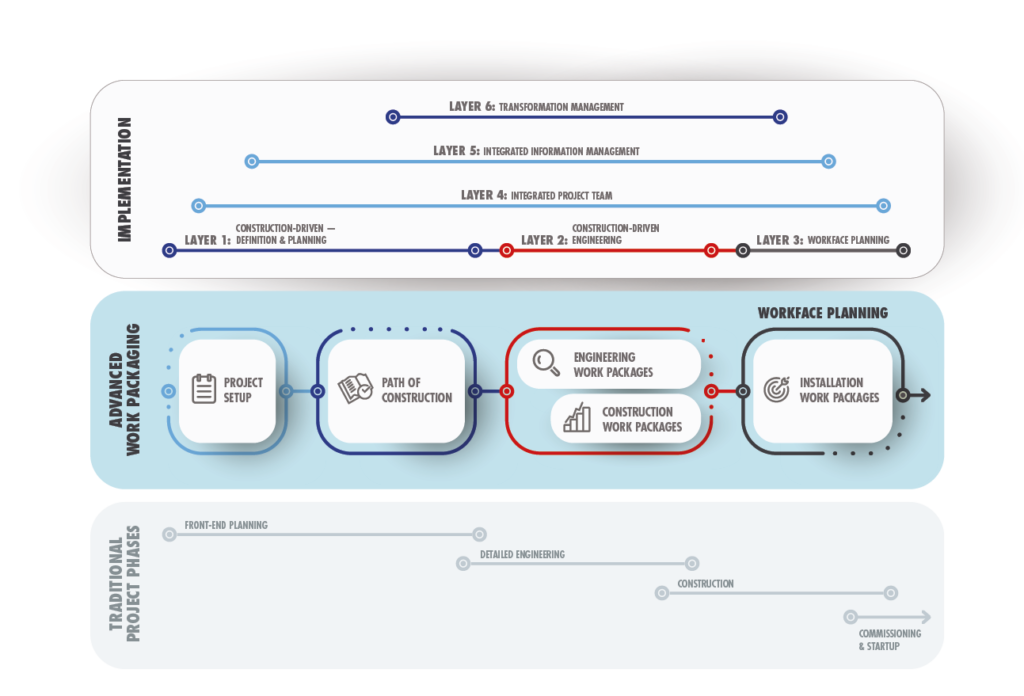Transformation management, also known as change management, ensures that new organizational initiatives succeed
Transformation management is the pinnacle of Concord®’s Advanced Work Packaging (AWP) implementation strategy, the secret sauce that separates the good from the great.
Anyone who coaches teams through AWP implementation will tell you about construction-driven definition, planning and engineering; they’ll explain workface planning and they might even touch on the importance of integrated information management. We are the first in our sector to talk about transformation management as a cornerstone for AWP implementation success.
What is Transformation Management in Capital Projects
The decision to transition to Advanced Work Packaging amounts to a wholesale transformation in how you do business. It’s not about a few discrete changes in a single system or team; it’s a portfolio of interconnected initiatives that will impact every person in your organization.
Change management tools can help. This includes make a business case, cultivating in-house leaders, engaging your stakeholders, getting early results and executing with discipline — standard change management practices that have been proven to work in organizations across all sectors.
The goal of transformation is to implement a business model that better supports the organizational mission and vision. It can be unpredictable, experimental, and risky. Some initiatives in the transformation portfolio can succeed while others may fail — indeed, the transformation to Advanced Work Packaging itself may fail even if some of the changes succeed.
The takeaway? Capital project is a people business, and people resist change. You must have a comprehensive strategy to bring your people along on your business transformation journey.
Transformation management is both a top-down and a bottom-up endeavour.
Olfa Hamdi Tweet
Top-Down, Bottom-Up, or Both?
Transformation management is both a top-down and a bottom-up endeavor. The move to Advanced Work Packaging relies, first and foremost, on buy-in from all levels of senior management. If the organization’s leadership isn’t all-in on AWP, the transformation is destined to fail.
It’s also imperative that people at all levels of the organization are given the training and consistent, proactive support they need to understand how the transition to AWP will impact their unique roles. Engineers, workface planners, procurement professionals, scheduling staff, construction leaders and contractors will all need varying levels of education, starting with a basic understanding of Advanced Work Packaging. You’ll definitely need an AWP Champion!
What are the Signs That You Need Transformation Mangagement?
The decision to transition to construction-driven capital projects comes with a host of challenges that can overwhelm even the most determined leaders. After more than 10 years working with organizations making this shift, I can tell you there are five clear signs that you need to start implementing proactive transformation management strategies.
Sign #1: The Magic Button Bias
There is no magic button that can transform your company into a construction-driven capital project organization. Leadership teams who are struggling with AWP implementation often start looking for a magic button — a consultant, a piece of technology, a new hire — who will solve the problems that come with transformation. There is no magic button; the only way forward is through. The only solution is to adopt effective transformation management strategies.
Sign #2: The Organization Won’t Spend on Training
This is a huge red flag. If the company won’t invest in training people to understand and implement Advanced Work Packaging, it’s a sign that leaders do not fully understand the impact that AWP will have on the organization and the people in it. Education in change and transformation management is the first step to overcoming this hurdle.
Sign #3: The Organizational Culture Does Not Encourage Change
Peter Drucker was right, culture eats strategy for breakfast. If your organizational culture penalizes people who change, innovate and improve, you’ll have trouble implementing Advanced Work Packaging. Transformation management can help.
Sign #4: The Silver Bullet Subterfuge
Like the Magic Button Bias, the Silver Bullet Subterfuge is also used by leadership teams who are struggling to deal with the challenges of transformation. In this case, faith is placed in a single tool — a silver bullet — usually a piece of software that promises to “automate” the transition to Advanced Work Packaging. While there are very good pieces of software available to support people in their efforts to transition to construction-driven project management, no tool can substitute for transformation management.
Sign #5: The Troublemakers Are Winning the War
Every organization struggles to some degree with entrenched team members who cannot be convinced that change is both necessary and good. If these folks start to gain a following in your organization, you need to step in and stop them from undermining the transformation agenda. Transformation management tools can support your leadership team in bringing these reticent team members along — even if they’re not happy about it.
This is the second-last article in our series on Advanced Work Packaging Implementation Layers. In the coming weeks, we’ll be publishing a summary of our articles on this topic so that you can share the series with your team and use it as a jumping off point for discussion. We hope you’ve found the series helpful.
If you’re interested in working with Concord® to implement transformation management strategies in your own organization, contact us today.






